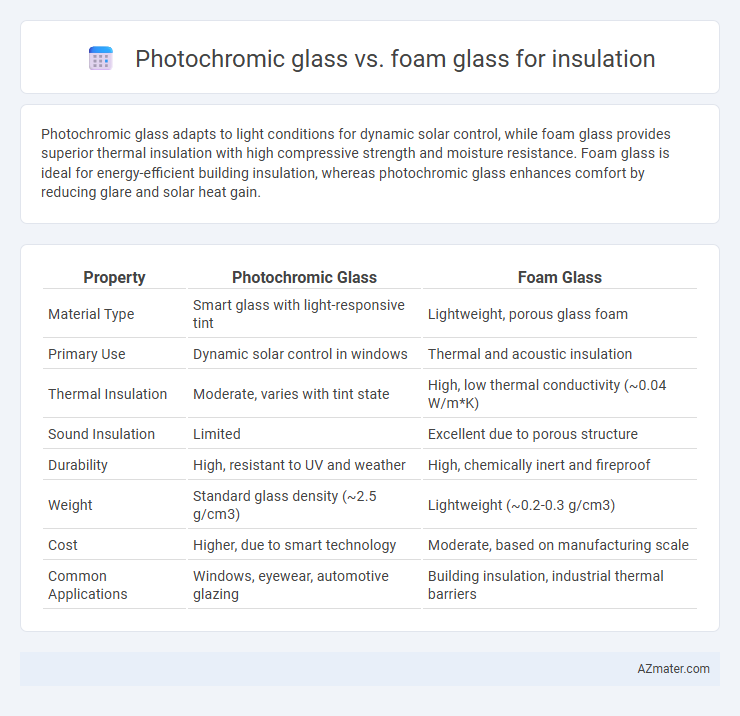Photochromic glass adapts to light conditions for dynamic solar control, while foam glass provides superior thermal insulation with high compressive strength and moisture resistance. Foam glass is ideal for energy-efficient building insulation, whereas photochromic glass enhances comfort by reducing glare and solar heat gain.
Table of Comparison
| Property | Photochromic Glass | Foam Glass |
|---|---|---|
| Material Type | Smart glass with light-responsive tint | Lightweight, porous glass foam |
| Primary Use | Dynamic solar control in windows | Thermal and acoustic insulation |
| Thermal Insulation | Moderate, varies with tint state | High, low thermal conductivity (~0.04 W/m*K) |
| Sound Insulation | Limited | Excellent due to porous structure |
| Durability | High, resistant to UV and weather | High, chemically inert and fireproof |
| Weight | Standard glass density (~2.5 g/cm3) | Lightweight (~0.2-0.3 g/cm3) |
| Cost | Higher, due to smart technology | Moderate, based on manufacturing scale |
| Common Applications | Windows, eyewear, automotive glazing | Building insulation, industrial thermal barriers |
Introduction to Photochromic and Foam Glass Insulation
Photochromic glass adjusts its tint in response to sunlight, reducing heat gain and enhancing energy efficiency in building insulation. Foam glass insulation consists of closed-cell, lightweight glass foam that provides excellent thermal resistance and moisture barrier properties. Both materials contribute to improved thermal performance, with photochromic glass focusing on dynamic solar control and foam glass providing stable, long-lasting insulation.
Understanding Photochromic Glass: Features and Functionality
Photochromic glass adapts its tint in response to sunlight, reducing heat gain while maintaining natural light, enhancing energy efficiency in buildings. This dynamic glazing technology offers UV protection and glare control, contributing to improved indoor comfort compared to traditional insulation materials like foam glass. Unlike foam glass, which provides static thermal insulation through its porous structure, photochromic glass actively regulates solar radiation, making it ideal for environments with variable sun exposure.
Foam Glass Insulation: Composition and Advantages
Foam glass insulation is composed of crushed glass particles fused into a lightweight, porous structure using heat and gas expansion, resulting in excellent thermal insulation properties. Its closed-cell design makes it highly resistant to moisture, fire, and pests, providing long-lasting durability and enhanced energy efficiency. Unlike photochromic glass, foam glass insulation excels in structural stability and environmental sustainability, making it ideal for both industrial and residential insulation applications.
Comparing Thermal Insulation Properties
Photochromic glass offers variable light transmission but generally has lower thermal insulation values compared to foam glass, which exhibits superior thermal resistance due to its closed-cell structure. Foam glass provides a high R-value, making it more effective in minimizing heat transfer and enhancing energy efficiency in building insulation. The dense, impermeable nature of foam glass also prevents moisture infiltration, further improving its thermal insulation performance over photochromic glass.
Energy Efficiency: Photochromic vs Foam Glass
Photochromic glass enhances energy efficiency by dynamically adjusting solar heat gain and natural lighting, reducing reliance on artificial cooling and lighting systems. Foam glass provides superior thermal insulation with low thermal conductivity and excellent moisture resistance, effectively minimizing heat loss through building envelopes. Combining photochromic glass's adaptive solar control with foam glass's insulating properties creates a comprehensive energy-efficient solution for modern construction.
Durability and Longevity: Which Performs Better?
Photochromic glass offers moderate durability with its ability to withstand UV radiation and environmental factors, but it is more prone to surface scratches and impact damage compared to foam glass. Foam glass excels in longevity due to its closed-cell structure, providing exceptional resistance to moisture, mold, and fire, which enhances its durability in harsh conditions. For insulation purposes prioritizing long-term performance, foam glass generally outperforms photochromic glass in terms of durability and lifespan.
Cost Analysis: Investment and Long-term Value
Photochromic glass typically involves higher upfront costs due to advanced technology and manufacturing processes, making its initial investment significantly greater than foam glass. Foam glass offers a more affordable initial expenditure with excellent thermal insulation and durability, providing a balanced cost-to-performance ratio over time. Long-term value for photochromic glass arises from energy savings related to dynamic light control, while foam glass ensures consistent insulation efficiency and minimal maintenance costs over its lifespan.
Environmental Impact and Sustainability
Photochromic glass contributes to energy efficiency by reducing the need for artificial lighting and cooling, thereby lowering carbon emissions, while its manufacturing process may involve higher energy consumption compared to foam glass. Foam glass insulation is highly sustainable due to its use of recycled glass and excellent thermal and moisture resistance, which enhances building longevity and reduces waste. Both materials support eco-friendly construction, but foam glass offers a more significant advantage in circularity and minimal environmental footprint during production.
Application Areas: Where Each Excels
Photochromic glass excels in architectural applications requiring adaptive solar control, such as smart windows in commercial buildings that optimize natural light and reduce glare. Foam glass is ideal for thermal insulation in industrial settings, including cryogenic tanks, pipe insulation, and roofing systems due to its high compressive strength and moisture resistance. While photochromic glass improves energy efficiency through dynamic light modulation, foam glass provides durable, lightweight insulation for harsh environments.
Choosing the Right Glass Insulation for Your Needs
Photochromic glass offers dynamic light control by adjusting transparency according to sunlight, enhancing energy efficiency and comfort in spaces with variable light exposure. Foam glass provides superior thermal insulation, moisture resistance, and durability, making it ideal for environments requiring robust temperature regulation and structural strength. Selecting between photochromic and foam glass depends on prioritizing either adaptive light management or optimal thermal insulation for your specific building requirements.

Infographic: Photochromic glass vs Foam glass for Insulation
 azmater.com
azmater.com